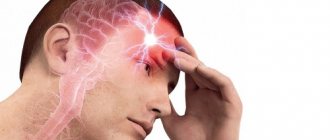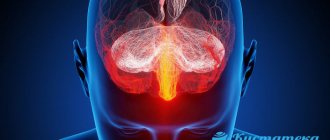Autonomic neurosis refers to various disorders of the human autonomic nervous system. And the symptoms of autonomic nervousness are most characteristic of disturbances in the functioning of the parasympathetic and sympathetic parts. Autonomic neurosis is a very “mysterious” disease, since medical diagnosis of which, as a rule, does not reveal disturbances in the functioning of the organs that patients complain about. This is due to the fact that the human autonomic nervous system is only part of the entire nervous system and acts as a connecting link for all organs and systems of the body.
Causes of vegetative neurosis
Among the most common causes of vegetative neurosis:
- increased lability of the autonomic nervous system;
- traumatic brain injuries that lead to brain damage;
- individual characteristics of the body due to gender (menopausal vegetoneurosis in women), age;
- acute and chronic infectious diseases;
- prolonged stay in a state of severe stress;
- non-compliance with the daily routine and healthy eating rules, which provoked exhaustion;
- mental and physical fatigue;
- psychological trauma;
- intoxication of the body;
- unfavorable environmental conditions;
- change of climate zone.
Often the causes of vegetative neurosis are associated with mental trauma received in childhood and internal conflicts. The disease can also be caused by frequent family quarrels and conflicts at work. Women may experience vegetative neurosis during pregnancy due to hormonal changes.
Disease therapy
If symptoms of neurosis and VSD occur, the patient is advised to seek help from a doctor. He will examine the patient and collect anamnesis, which will allow him to make a diagnosis. If necessary, laboratory and instrumental examinations are prescribed.
Treatment of pathology must be comprehensive. This takes into account the type and severity of the disease, as well as the individual characteristics of the patient. Treatment of the disease is carried out using psychotherapeutic techniques, medications and physiotherapeutic procedures.
The main cause of neuroses in vegetative-vascular dystonia is nervous overstrain and mental trauma. It is impossible to eliminate them with the help of medications. In this case, the use of psychotherapy is recommended.
A highly qualified specialist works with a person, which ensures the effectiveness of treatment. To eliminate the causes of the pathological condition, the use of simulation and conversation is recommended. In some cases, a frightening situation is created. Thanks to the use of innovative techniques, the patient learns to control his emotions.
To normalize the state of the nervous system, simultaneous use of physical education is recommended. A set of gymnastic exercises is developed by the doctor in accordance with the physical characteristics of the person.
Vegetative-vascular dystonia is a serious disease that is accompanied by a variety of symptoms such as:
nausea
,
lump in the throat
,
noise in ears
etc. Often in pathology, when exposed to provoking factors, neurosis develops. This pathological process has several varieties, which are determined in accordance with the characteristics of its course. If symptoms of neurosis and vegetative-vascular dystonia occur, the patient is recommended to undergo treatment, which requires the use of a whole range of methods.
Autonomic disorders in neuroses require drug treatment. Doctors use a wide range of medications to treat symptoms of the disorder.
Treatment usually begins with sedatives. They help to calm down, get rid of feelings of anxiety and increased nervousness. Such products are made on the basis of herbs and medicinal plants (hawthorn, valerian, lemon balm, mint). “Novopassit” and “Persen” have proven themselves well.
To treat serious nervous disorders, tranquilizers are used. They are prescribed in cases of prolonged depression, the emergence of fears and phobias that interfere with leading a full life. They also help cope with panic attacks and increased anxiety. Among the tranquilizers, Diazepam, Atarax or Tranxen are usually prescribed. They can only be purchased with a doctor's prescription.
Drug treatment of autonomic neurosis cannot be imagined without the use of nootropics and vascular agents. They help improve memory, normalize brain function and vascular function. For this purpose, Piracetam, Phenibut, and Cerebrolysin are prescribed.
In the process of diagnosis and treatment, it is important to establish whether there is a connection between autonomic neurosis and psychological trauma and disorders. Otherwise, drug therapy will be ineffective.
Quite often, a person does not even suspect that the traumas experienced in childhood are the cause of increased anxiety in adulthood. Being in constant conflict with himself and the world around him, the patient experiences prolonged depression. This negatively affects the functioning of his autonomic system.
In this case, psychotherapy can be one of the effective treatment methods. These can be either individual meetings or group sessions. Through various techniques (hypnosis, self-analysis), the patient gets rid of old memories and traumas. To find peace and mental balance, you can use meditative techniques and auto-training. With their help, patients begin to perceive reality in a new way and become more confident.
Symptoms of vegetative neurosis
Vegetative neurosis is characterized by disorders of the cardiovascular, genitourinary and digestive systems. Patients also often experience vasomotor syndrome, characterized by:
- migraine;
- pulsation in the head;
- surges in blood pressure;
- muscle and joint pain.
Asthenic syndrome with vegetative dystonia manifests itself:
- constant weakness that does not go away even after rest;
- increased fatigue;
- irritability;
- attention disorders (difficulty concentrating on the work at hand);
- sudden mood swings;
- intolerance to bright light and loud sounds.
Other syndromes that are signs of vegetative neurosis include:
- Skin-vegetative. The skin becomes dry, pigment spots and cracks appear on it. Or, on the contrary, there is an increased secretion of sweat and sebaceous glands.
- Trophic. Different muscle groups atrophy. Erosive and ulcerative lesions form. The condition of nails and hair deteriorates significantly.
- Vegetative-allergic. Allergic rashes appear on the skin. The patient complains of a runny nose and conjunctivitis.
- Visceral. The syndrome is characterized by stool disturbances, temporary lack of oxygen, and slower flow of bile.
- Phobic. The patient has unreasonable fears. At the same time, he himself understands the groundlessness of his experiences, but cannot get rid of them.
- Hypochondriacal. The patient is very concerned about his health. He constantly suspects that he has a fatal disease.
Symptoms of vegetoneurosis of the heart:
- heart rhythm disturbance;
- cardalgia;
- pain in the chest area;
- feeling of a sinking heart;
- cardiopalmus;
- dyspnea;
- blueness of fingers and toes.
At the same time, you need to understand that in reality there is no pathological condition that disrupts the functioning of the cardiovascular system. The discomfort is false.
Vegetoneurosis of the stomach manifests itself:
- abdominal pain;
- belching;
- diarrhea/constipation;
- loss of appetite;
- vomiting, nausea.
If you notice similar symptoms, consult a doctor immediately. It is easier to prevent a disease than to deal with the consequences.
Types of autonomic neuroses
All manifestations of autonomic neurosis are conditionally neurosomatic or psychopathological.
Neurosomatic autonomic neurosis most often manifests itself in disorders of the cardiovascular system, respiratory and genitourinary systems, as well as in the functioning of the digestive organs. Impaired movement function, speech function, loss of sensitivity, prolonged migraines, anorexic nervous disorders, dyskinesia - this is not a complete list of possible symptoms of neurosomatic autonomic neurosis.
Psychopathological autonomic neurosis is clearly expressed by the following psychological disorders: asthenia, hypochondria, depression, the presence of a number of phobias, etc.
Vegetovascular dystonia is accompanied by psychoemotional disorders. Their features directly depend on the type of neurosis. He can be:
- Asthenic. The main feature of this type of pathology is a sudden change in mood. Since the patient experiences a loss of strength and nervousness, this leads to irritability and mood swings. The disease is accompanied by increased fatigue, so a person cannot perform even usual activities for a long time. The disease is accompanied by trembling in the body and increased heart rate.
- Hysterical. Patients experience paroxysmal emotional outbursts. The cause of hysteria is self-suggestion. A person loses control over his emotions and is able to overwhelm himself. If the disease is not treated promptly, convulsions, paralysis and hallucinations are observed. Patients experience a sudden onset and end of tantrums. This type of pathology is most often observed in the fairer sex. Most women complain that they often have headaches.
- Psychasthenia. It is characterized by the patient’s fixation on negative thoughts that appear spontaneously.
- Depressed. This type of pathology is observed if a person cannot independently cope with difficult life situations. A person gets the feeling that no one needs him. The disease is accompanied by rapid fatigue. In the pathological process, the occurrence of emotional and physical weakness is noted. If the pathology occurs in an advanced form, then this leads to thoughts of suicide.
Diagnosis of vegetative neurosis
Diagnosis of vegetative neurosis is based on studying the clinical picture after excluding the presence of organic pathologies. That is, first the patient is prescribed an examination of those organs and systems whose functioning he complains about. If organic disorders cannot be detected, skin and somatic reflexes are additionally examined.
Many patients have autonomic asymmetry. To assess the degree of excitability of the sympathetic nervous system, dermographism (local vasomotor response that appears after streak irritation of the skin) is examined.
What happens in the body during a nervous allergy?
Inflammatory mediators are specific proteins in the body, the number of which increases during experiences and stress. This reaction has been proven by laboratory studies - in the blood of people who have just experienced an emotional shock, the level of histamine is significantly higher than normal. Because of this, the body does not need an allergen at all for inflammation to occur. For a nervous allergy to occur, it is not at all necessary that an irritating substance be present in the body.
During periods of severe emotional shock, even a familiar food product can easily trigger strong reactions in the body. Only after a few days a person will be able to feel the symptoms of an allergy. Because of this, it is impossible to determine exactly what caused such changes. Even if you manage to identify the irritant, during periods of a peaceful and carefree life it will not bring you any discomfort.
How to treat vegetoneurosis
Vegetoneurosis is curable. Treatment prescribed for this disease is aimed at regulating and normalizing the functioning of the autonomic nervous system. Choosing the right daily routine and rest is of great importance. Frequent walks in the fresh air, good sleep, and avoidance of stress are important. Sanatorium-resort treatment contributes to a speedy recovery.
With vegetative neurosis, daily physical therapy is necessary. Moderate physical activity has a good effect on the activity of the autonomic nervous system and increases its ability to function normally.
The priority direction of treatment of vegetative dystonia is psychotherapy. The sessions calm the patient and help him get rid of psycho-emotional stress. The psychotherapist identifies factors that increase symptoms and develops a plan to eliminate them.
Drug therapy for vegetative neurosis includes taking drugs that improve sleep, sedatives and painkillers, as well as drugs that help regulate the functioning of the nervous system. The dosage is determined individually.
Treatment of vegetative neurosis with herbs
According to reviews, treatment of vegetative neurosis with herbs allows one to achieve good results. Among the effective means:
- Infusion of flowers and fruits of hawthorn. Mix flowers and fruits in equal proportions. 3 tbsp. Pour the resulting mixture with 2 cups of boiling water. Leave for 2 hours. Take a glass 3 times a day.
- Eleutherococcus rhizomes in alcohol. Pour 50 g of rhizomes with 0.5 liters of alcohol. Leave for 2 weeks. Take 30 drops half an hour before meals. Treatment course – 1 month.
- Tincture from ginseng roots. Wash, dry, and chop fresh ginseng roots. Pour 100 g of roots with a liter of vodka. Leave for 3 weeks, shaking occasionally. Filter. Take 20 drops 3 times a day half an hour before meals. Course duration – 1 month. After a 10-day break, repeat.









